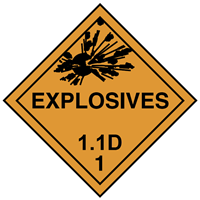
 Print
Print
Chemical Datasheet
UREA NITRATE, [DRY] |

|
Chemical Identifiers
| CAS Number |
UN/NA Number |
DOT Hazard Label |
USCG CHRIS Code |
|
|
|
|
none
|
| NIOSH Pocket Guide |
International Chem Safety Card |
|
none
|
none
|
NFPA 704
data unavailable
General Description
A crystalline compound arising from the neutralization of urea with nitric acid. Melting point 152°C. Slightly soluble in water. Soluble in alcohol. Primary hazard is blast of an instantaneous explosion, not flying projectiles or fragments.
Hazards
Reactivity Alerts
- Explosive
- Strong Oxidizing Agent
Air & Water Reactions
Easily ignited. Burns very vigorously to generate toxic oxides of nitrogen. Slightly soluble in water.
Fire Hazard
Excerpt from ERG Guide 112 [Explosives - Division 1.1, 1.2, 1.3 or 1.5]:
MAY EXPLODE AND THROW FRAGMENTS 1600 METERS (1 MILE) OR MORE IF FIRE REACHES CARGO. (ERG, 2024)
Health Hazard
Excerpt from ERG Guide 112 [Explosives - Division 1.1, 1.2, 1.3 or 1.5]:
Fire may produce irritating, corrosive and/or toxic gases. (ERG, 2024)
Reactivity Profile
UREA NITRATE is explosive when left in dry state. Wetting reduces possibility of explosion but may explode under prolonged exposure to heat or fire, even when wet. It reacts with strong oxidizer such as perclorates and hypochlorites. With hypochlorites it forms a compound nitrogen trichloride which explodes spontaneously in air (J. Am. Chem. Soc. 63:3530-32). Organic nitrates may explode when shocked, exposed to heat or flame or by spontaneous chemical reaction. It must be stored in a cool, ventilated place, away from acute fire hazards and easily oxidized materials. Also reacts violently with Al; BP; cyanides; esters; PN2H; P; NaCN; SnCl2; sodium hypophosphite; thiocyanates. Dangerous disaster hazard due to fire and explosion hazard. On decomposition, they emit toxic fumes. They are powerful oxidizing agents which may cause violent reaction with reducing materials. Nitrates should be protected carefully in storage. (SAX and Lewis, 1987) p.664. Decomposition is catalyzed by the presence of heavy metals such as lead or iron in trace amounts [Bretherick, 1995, pg. 201]. Produces toxic oxides of nitrogen during combustion. Decomposed with explosive evolution of gas during the evaporation of an alkaline solution. [Bretherick, 1995, p. 201].
Belongs to the Following Reactive Group(s)
- Amides and Imides
- Nitrate and Nitrite Compounds, Inorganic
Potentially Incompatible Absorbents
Use caution: Liquids with this reactive group classification have been
known to react with the
absorbents
listed below.
- Cellulose-Based Absorbents
- Expanded Polymeric Absorbents
Response Recommendations
Isolation and Evacuation
Excerpt from ERG Guide 112 [Explosives - Division 1.1, 1.2, 1.3 or 1.5]:
IMMEDIATE PRECAUTIONARY MEASURE: Isolate spill or leak area immediately for at least 500 meters (1/3 mile) in all directions.
LARGE SPILL: Consider initial evacuation for 800 meters (1/2 mile) in all directions.
FIRE: If rail car or trailer is involved in a fire, ISOLATE for 1600 meters (1 mile) in all directions; also, initiate evacuation including emergency responders for 1600 meters (1 mile) in all directions. (ERG, 2024)
Firefighting
Excerpt from ERG Guide 112 [Explosives - Division 1.1, 1.2, 1.3 or 1.5]:
CARGO FIRE: DO NOT fight fire when fire reaches cargo! Cargo may EXPLODE! Stop all traffic and clear the area for at least 1600 meters (1 mile) in all directions and let burn. Do not move cargo or vehicle if cargo has been exposed to heat.
TIRE OR VEHICLE FIRE: Use plenty of water - FLOOD it! If water is not available, use CO2, dry chemical or dirt. If possible, and WITHOUT RISK, use unmanned master stream devices or monitor nozzles from maximum distance to prevent fire from spreading to cargo area. Pay special attention to tire fires as re-ignition may occur. Stand by, at a safe distance, with extinguisher ready for possible re-ignition. (ERG, 2024)
Non-Fire Response
Excerpt from ERG Guide 112 [Explosives - Division 1.1, 1.2, 1.3 or 1.5]:
ELIMINATE all ignition sources (no smoking, flares, sparks or flames) from immediate area. All equipment used when handling the product must be grounded. Do not touch or walk through spilled material. DO NOT OPERATE RADIO TRANSMITTERS WITHIN 100 METERS (330 FEET) OF ELECTRIC DETONATORS. DO NOT CLEAN-UP OR DISPOSE OF, EXCEPT UNDER SUPERVISION OF A SPECIALIST. (ERG, 2024)
Protective Clothing
Excerpt from ERG Guide 112 [Explosives - Division 1.1, 1.2, 1.3 or 1.5]:
Wear positive pressure self-contained breathing apparatus (SCBA). Structural firefighters' protective clothing provides thermal protection but only limited chemical protection. (ERG, 2024)
DuPont Tychem® Suit Fabrics
No information available.
First Aid
Excerpt from ERG Guide 112 [Explosives - Division 1.1, 1.2, 1.3 or 1.5]:
Refer to the "General First Aid" section. (ERG, 2024)
Physical Properties
Flash Point: data unavailable
Lower Explosive Limit (LEL): data unavailable
Upper Explosive Limit (UEL): data unavailable
Autoignition Temperature: data unavailable
Melting Point: data unavailable
Vapor Pressure: data unavailable
Vapor Density (Relative to Air): data unavailable
Specific Gravity: data unavailable
Boiling Point: data unavailable
Molecular Weight: data unavailable
Water Solubility: data unavailable
Ionization Energy/Potential: data unavailable
IDLH: data unavailable
AEGLs (Acute Exposure Guideline Levels)
No AEGL information available.
ERPGs (Emergency Response Planning Guidelines)
No ERPG information available.
PACs (Protective Action Criteria)
No PAC information available.
Regulatory Information
EPA Consolidated List of Lists
No regulatory information available.
CISA Chemical Facility Anti-Terrorism Standards (CFATS)
No regulatory information available.
OSHA Process Safety Management (PSM) Standard List
No regulatory information available.
Alternate Chemical Names


 Print
Print
